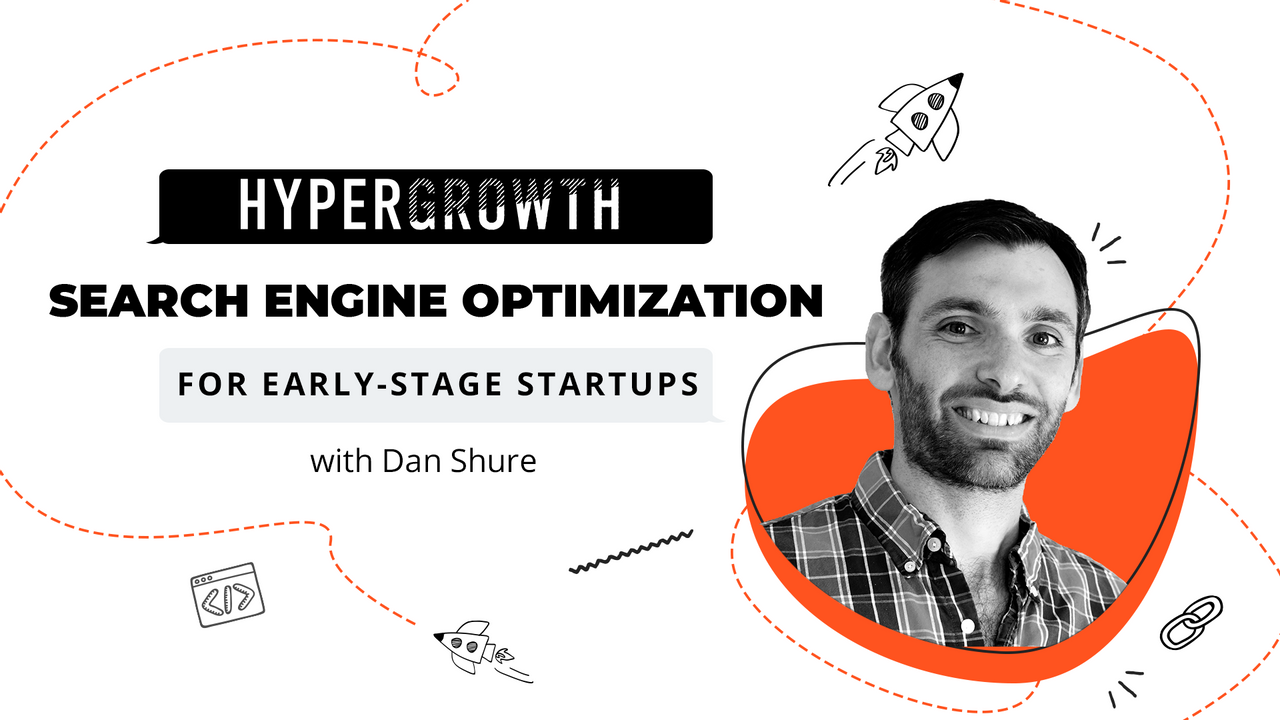Search Engine Optimization for Early-Stage Startups

SEO is one of the marketing fields riddled with the most misconceptions and knowledge gaps. So it's needless to say we've been itching to bring a guest we can dive into SEO with. And we're happy Dan Shure, the founder of Evolving SEO and host of Experts on the Wire, agreed to go on screen and share his SEO expertise.
Dan has consulted organizations such as GBH (Boston's NPR and PBS), Zappos, Harvard Business Review, Gartner, ButcherBox, and many others – so he can draw on his experience with a variety of businesses to bring founders and growth hackers relevant advice.
Paying attention or focusing on SEO
I wanted to kick off my talk with Dan with a slightly cheeky question – but one that I believe is important. Since there's so much a new startup's growth resources can be focused on, is SEO always the best thing to work on from the get-go?
Dan made an important distinction between "focusing on" and "paying attention to" SEO. And while SEO might not be the ideal first growth channel to focus on, he said, "Every business should pay attention to SEO in some way or another." This can mean as little as setting up your Search Console or creating a website that Google can actually crawl and access.
But no matter which pathway you choose, sooner or later, you'll probably want to start driving some of that sweet organic search traffic. And there are a few ways we can do that, depending on the type of queries you want to address.
SEO for product-related keywords
The first thing to look into would be the so-called "bottom of the funnel searches." These are directly related to your solution's category – and usually indicate users are already conducting product research or are close to a final decision.
The most critical first step here is to figure out if there are relevant product or service keywords. If there aren't any direct product searches, you might want to expand and look for a generic search term. This is the difference between a search like "video sales tool" and a generic one such as "remote selling."
If there are a few different search phrases that come up, you might want to create different versions of your landing pages to account for each one. This will improve your SEO, and it will also ensure message match between what a person thinks they want and what you're telling them you'll provide.
But what if you want to create something really innovative? How can you still work on SEO if your vision includes building a category-forming product (think of Drift's "conversational marketing" or Hubspot's "inbound marketing")?
Well, according to Dan, there are a couple of directions you can take:
- "Put a flag in the ground" by creating educational content. Hubspot didn't make inbound marketing a staple term overnight – the team invested in a lot of content that described the concept.
- Start with an existing concept in your niche and look for key phrases that include "cons of..." or "... alternative". They will help you attract people looking for something new but who don't know what to call it yet.
- If some competitors are taking a contrarian approach like you, you can input their domain in a keyword research tool and look through the queries that are bringing them traffic. They can give you some good ideas.
In any case, being an innovative visionary doesn't need to come at the expense of search traffic. You can create a new category while still using existing product searches to attract an audience.
SEO for top of the funnel searches
We started with product-related queries because they can get you visitors who are ready to buy. But that doesn't mean that the top and middle of the funnel content should be left out. It can help you attract the right people, even if they're not yet ready to get your solution.
There will be a lot of search terms you can create content for. But if search traffic is your primary goal, you'll have to choose them right. If you're still a new entrant and you don't have high domain authority, you'll need to go after lower-competition searches that have to do with sub-topics in your category.
It's a bit of a divergent approach. You take a topic you want to address (e.g., "video marketing") and look at the results that come up on the first page of Google. The first thing you want to look at is what Dan calls "content gap" – lapses in the results you identify and can actually include in your content. Then look for an "authority gap" – it'll tell you whether or not ranking for this query is possible. Analyze the SERP links with the MozBar and look at the domain authority of the top-ranking sites. If, for example, your own site has an authority of 10 and you see that the page one sites are around DA of 50 or less, then you have a shot.
Let me repeat that: a site with little authority can actually outrank more recognized domains. This can happen as long as they are focusing on their own niche and producing top-quality content. This was a huge revelation for me. I've heard other experts say that if you're off by more than 10 points on your DA than the other Google SERP darlings, you're more or less doomed. But Dan was completely clear: while a small niche site won't be able to compete on the really broad terms, they can definitely outrank a site with higher authority for niche terms they might be uniquely suited to address.
But what if you still feel like the original search term is too broad or too challenging to work with? You can use it as what Dan calls a "seed term." It's a broad key phrase designed to unlock other content ideas. Just put your seed term through a tool like Keyword Keg or KeywordTool.io and look at the related searches to find a relevant subtopic you might want to cover. If we take the "video marketing" example again, then you might find opportunities with "video marketing examples" or "video marketing for restaurants."
What matters with content SEO – and what's BS?
So, we know what content we'll be producing. How do we make it better?
Dan was kind enough to dispel a few standard pieces of SEO advice he now believes are obsolete:
- word count doesn't matter – it all depends on how well you cover the topic with your work;
- keyword density is a thing of the past – relax and don't stuff your content with the same words over and over again;
- bolding and underlining doesn't make Google notice specific terms more.
You can save your energy and direct it in a more impactful activity: making your content topically complete. To do this, Dan recommends using the TF-IDF tool.
TF-IDF stands for "term frequency - inverse document frequency." It basically explains how good you are at covering a topic thoroughly compared to your competitors. The tool looks at the top 20 results on Google for your search term. It analyzes the content of these results to bring you the 1-, 2-, and 3-word phrases that appear most often in the text. It's not a question of uncovering other keywords but finding supplemental topics.
For example, if you're creating a blog post for "espresso machine," you'll see the important features other authors focused on, like "milk frother" or "removable drip tray." This will help you expand your content draft to cover everything expected about the topic and make your piece more complete than the rest.
SEO misconceptions
I asked Dan about this as an afterthought, but it became one of the most exciting topics in our interview. It seems that SEO is regarded as this mystic field where experts gaze into a crystal ball, trying to decipher what The Mighty G is trying to tell us. But Dan doesn't base his recommendations on esoterics – he grounds them in experience.
Google search guidelines
The most popular current "SEO fads," according to Dan, are E-A-T and YMYL. E-A-T stands for "Expertise, Authoritativeness, Trustworthiness" and is a way to assess page quality. YMYL has to do with "pages or topics that could potentially impact a person's future happiness, health, financial stability or safety."
These are both human search evaluator guidelines – they are designed to help the teams at Google understand if a page really should be showing up high in the SERP or not. But they are just that – guidelines. Not automated algorithm elements or anything like that. So Dan says you should understand the principle behind them but not spend a ton of time fretting over the question "Does this draft sound Authoritative?"
Keyword difficulty in SEO tools
The second thing Dan is not impressed with is the scores SEO tools usually assign for keyword difficulty. He believes they are wildly inaccurate and mentioned cases where a low-difficulty keyword will be tough to rank for while a high-difficulty one would be way easier than expected.
So what do you do? You're better off analyzing the domain authority of the sites in top positions, as explained earlier in the conversation. And, of course, focus on creating engaging and valuable content.
Topic clusters
One of the prominent "inventions" of Hubspot, Dan believes topic clusters are "like a hammer looking for a nail." In his experience, there isn't any evidence that clusters rank more quickly than single keyword-optimized pieces.
Blog subdomains vs. subfolders
We've been repeatedly told that having your blog on a subdomain strips most of the SEO value, and you should definitely have the blog in a subfolder. Thanks to Dan, you can relax about it. He pointed out that there have been many times when even high-level Google members like Matt Cutts and John Mueller have explained that subdomains are OK.
The misconception seems to be coming from the idea that a blog set up as a subdomain of a giant blogging platform like Blogspot doesn't get the juice from the main domain. But if you're a product company and you want to have your blog on a separate subdomain for security or technology reasons, then do it.
Dan recommends making the subdomain look and feel like the main site so that the user doesn't have an idea he's switching between two. Think design styles, navigation, and so on. The more seamless the experience, the better.
Focus on the reader, and Google will recognize you for it
Throughout our talk, Dan was telling us to focus on one thing: the person visiting your site. You start with the user and what they are looking for in your keyword research. You create the most complete piece of content to be helpful to the reader. And then you make sure that there's a viable next step to direct these visitors to – be it a product offer, a signup request, or simply an invitation to subscribe to your newsletter.
As long as you're being helpful and following a few rules of thumb, SEO shouldn't be as mysterious as we believe it is. And there are a ton of tools and resources that come to help – you'll see Dan's recommendations below the video recording of our talk.








